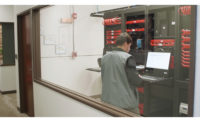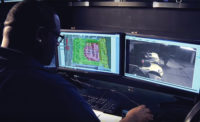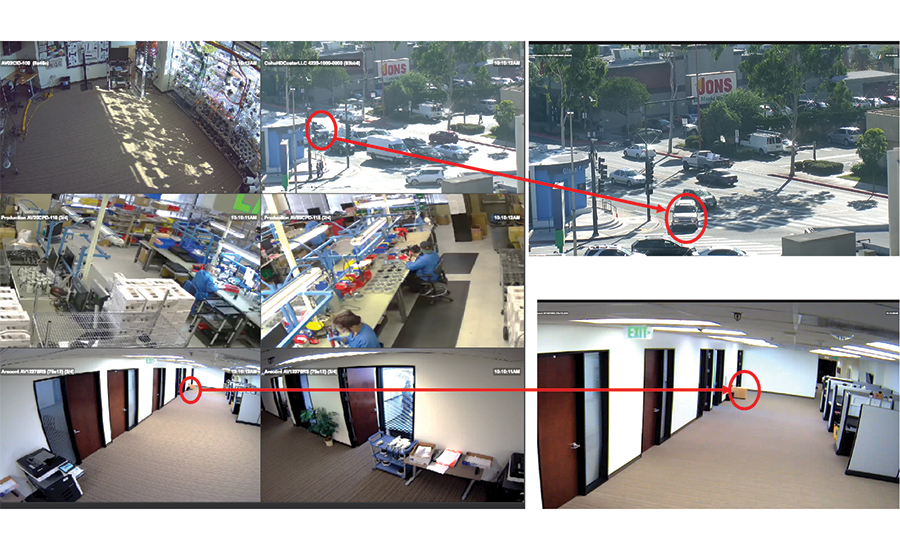Feeding the Growing Appetite for Video Surveillance Data
Increasing amounts of data and new models for analysis move solutions closer to proactive tools than merely reactive.

AI-enabled VMS promises to bring more reliability, better proactive responses, and fewer false alarms than traditional video analytics. And as AI systems progress and learn, they will become better tools for overall security and predictive behavior monitoring.
PHOTO COURTESY OF ARECONT VISION COSTAR

Improvements in technology have positioned VMS at the center of the movement to shift video surveillance from a reactive solution to a more proactive tool.
PHOTO COURTESY OF BOSCH SECURITY AND SAFETY


Video management software (VMS) is evolving from a pure security solution into a tool that also provides insight on operations and more. This means more automation is coming into play, and the increased adoption of analytics has created a democratization within the marketplace.
End users have access to more data than ever before — not only raw data, but actionable intelligence, as well.
“We’re no longer just talking about video surveillance; more data is being combined with video coming directly from other systems or data coming from the edge from cameras,” says Kyrillos Mossad, partner relation and integration manager, Hanwha Techwin America, Ridgefield Park, N.J. “There’s a lot more demand for data to converge with video.”
As a result, users of today’s video management systems are able to respond quickly to critical events as well as understand how their organization operates and how their customers behave.
Also contributing to this trend is an increased use of geolocation in monitoring and response.
“Map-based surveillance is making it possible for operators to get a better picture not only of what is happening but also where it is happening,” Villeneuve says. “Having access to all cameras as well as other security entities or sensors all on a single dynamic map is providing a better and more logical way of using a VMS. We’re definitely seeing more and more people rely on that kind of video rather than the standard monitoring style.”
One of the biggest benefits of all this data analysis is the ability to act proactively with greater insight into situations. While the focus of video has long been on crime deterrence and post-event investigation, documentation and potential prosecution, today’s open-architecture VMS and integrated technologies are changing the conversation and moving it closer to prevention, says Ken LaMarca, vice president of sales and marketing, OnSSI, Pearl River, N.Y.
“At the center of these integrations are leading-edge open architecture VMS that sit at the center of PSIM systems and enable analysis of incidents with correlation to data from access control, video analysis and other systems, creating meaningful events that may help prevent future incidents.”
“This growing science of what is being called ‘predictive analysis’ is becoming a larger focus for video surveillance systems and is a major driver of the move toward prevention,” LaMarca explains.
The Role of AI
At the heart of VMS’ ability to deliver advanced data analysis and enable proactive intervention is automation and, increasingly, artificial intelligence (AI). According to Troy Wideman, regional marketing manager, Bosch Security and Safety Systems, AI brings together the forensic aspect of recording to work hand-in-hand with proactive tools.
“It is the AI that provides the data for forensic searches as well as for proactive monitoring,” he says. “This same data is constantly being monitored to allow notifications of critical incidents as they happen and to draw the user’s attention to those events. This same data then can be used to pull up recorded video to further analyze the occurrences.”
Lately, there has been much more demand and for AI-based analytics used for forensics or real-time identification across multiple cameras, says Brian Carle, director of product strategy, Salient Systems, Austin, Texas.
“More specifically, facial recognition has garnered interest in a number of applications, as well as search analytics, which detect and classify objects found in recorded video, then allow for filtering to more quickly identify events,” he says.
While AI technology is nascent in today’s VMS solutions, Dean Drako, CEO, Eagle Eye Networks, Austin, Texas, believes it will grow significantly in its applications over the next decade.
“We will be able to more intelligently automatically flag issues that will need attention or anomalies,” he says. “AI will be able to learn what is normal and then when something out of the ordinary happens bring it to the forefront for attention.”
GPU Advances
One of the advances that is driving greater use of AI in VMS is graphics processing unit or GPU. Primarily used for accelerating the creation and output of images to a display device, these technologies offer a parallel processing structure that makes them more effective and efficient for processing images than traditional central processing units (CPU).
“AI-based analytics require an extreme level of computational capability to operate in video applications. GPU and other co-processing technologies have made such technologies practical,” Carle says. “Prior to the advent of widespread GPU integration, a computer’s CPU would perform all the processing of video, albeit with lower efficiency and higher cost. Now with GPU, the hardware component of the analytics deployment is lower cost and capable of processing a higher number of cameras.”
GPUs have been used in IT platforms for high-performance computing for multiple generations of products for applications for developers, design, research, gaming and video applications.
“GPU that are used for computational purposes and not graphical purposes — what are termed general-purpose GPUs — are now helping AI models operate much more efficiently and in a shorter period of time,” Mossad says. “There are VMS now that are capable of leveraging the GPU and CPU to decode video, making it a little bit more efficient on the system’s CPU. And now GPUs are being used as computational devices to something similar to what a CPU does, but much more robust and much more powerful.”
So far, says Jeff Whitney, vice president of marketing, Arecont Vision Costar, Glendale, Calif., AI has failed to live up to its promise, but continued GPU advancements could change that in the future.
“The initial AI systems that we see in the market today are limited in capabilities. While they may make great demos and can show the potential for replacing the basic video analytics found in many cameras today, real-world applications are more challenging. AI is a very compute-intensive application and thus can benefit in a properly designed complete system that can leverage GPU technology,” he says.
Still, there are currently GPU technologies that allow traditional computing machines to offload video decoding and rendering to external resources, which enables AI processing to be performed up to 50 percent more efficiently, says James Hoang, partnering and integration manager, Speco Technologies, Amityville, N.Y.
Privacy & Cyber Security
With all the data that’s being compiled and analyzed by VMS, network security has become even more critical, particularly in light of GDPR and other data privacy regulations that are emerging.
“There is more consciousness developing on the cyber security side of things because systems integrators and end users are putting more and more value into the evaluation of cyber security tools that will provide the appropriate level of security required to protect their physical or digital assets,” says David Lim, commercial lead product line manager, video, Genetec. “More and more, the tools that handle personal data should be secured by default and by design.”
Another area of cyber concern is the increasing move toward cloud-based VMS.
“Cloud recording…brings with it inherent security issues about where the video is stored, who could access it — such as hackers — and for how long,” says Bosch Security and Safety Systems’ Troy Wideman.
One way VMS can help with this is by managing updates that will ensure software and devices are prepared to address emerging cyber threats.
“With cyber security being one of the industry’s biggest and most threatening challenges, the ability to automatically push software patches and updates to customers is critical to ensure they have the latest protections and functionality,” says OnSSI’s Ken LaMarca. “Additionally, system hardening with the use of AES encryption and TLS 1.2 provides robust cyber security protection.”
In the end, it is up to the integrator to make sure their customers’ solutions are properly secured to meet internal requirements and external regulations.
“This speed-up allows the analysis of more complex images and at a faster rate, resulting in AI data that is more reliable and can be acted on in real-time. This is much improved over years past,” he says.
According to Tim Palmquist, vice president Americas, Milestone Systems, Beaverton, Ore., GPU and data management acceleration are exciting areas now, with innovations in the technology enabling the computing power to support machine learning and AI.
“The innovations in this area will disrupt the status quo in our industry as well as others and enable amazing innovation in the marketplace,” he says.
Due to the previous limitations of hardware processing power, machine learning or AI could only deploy shallow learning of very large data sets. This shallow learning is like looking at data in just three dimensions, says Keven Marier, director of technology business development, Milestone Systems.
“With recent, significant advances in processing power of GPUs, we can now utilize a deep learning approach where we can look at data in many more levels or dimensions, hence the word ‘deep,’” he says.
Given the role VMS play in data aggregation, namely to develop broad support for all relevant devices, which is especially important in the Internet of Things age, GPU will be helpful on that front as well, Marier says.
A couple areas where GPU technology is becoming increasingly useful are for H.265 decoding and manipulation of data sent back from AI-capable devices. However, the cost of GPU technology can significantly increase the price of a system, which could be a factor in turning customers away from certain solutions, Wideman says.
“We must learn to explain why customers may need this in their systems,” he says.
Without question, VMS are leading the charge in helping video surveillance systems become more proactive, which is good on many levels. Proactivity can increase safety and security, and it makes sense that security systems should allow for this shift in application. Advancements in AI and other technologies will place VMS at the center of the massive and growing amount of data that is being generated by security and non-security systems alike. Integrators who recognize these trends and help their customers take advantage of them will be well-positioned for success as VMS evolve and improve.
More Online
For more on video management systems, visit SDM’s website where you’ll find the following articles:
“VMS Integrations in Action”
www.SDMmag.com/vms-integrations-in-action
“Securing VMS Against Cyberattacks”
Looking for a reprint of this article?
From high-res PDFs to custom plaques, order your copy today!







